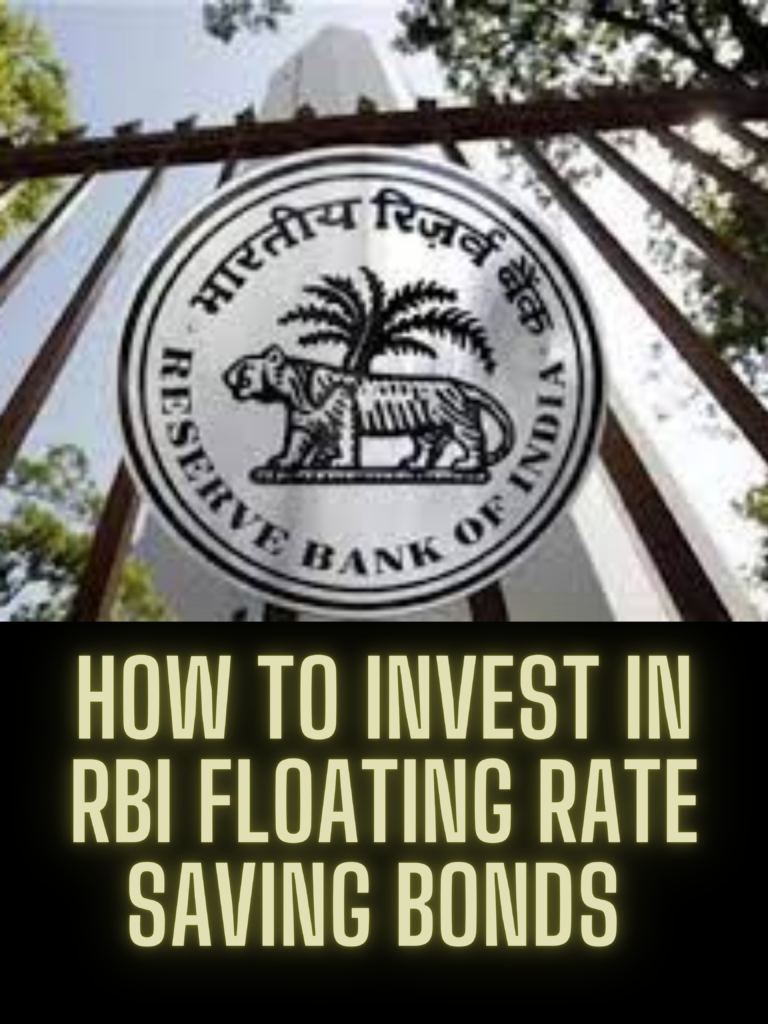Introduction:
Investing in RBI Floating Rate Bonds can be a wise choice for those seeking a low-risk investment with guaranteed returns. These bonds offer a fixed interest rate, and here’s how you can invest in them, understand their maturity period, withdrawal options, and their pros and cons.

Investing in RBI Floating Rate Bonds:
- Open a Bond Ledger Account:
- To begin your investment journey in RBI Floating Rate Savings Bonds, visit the RBI Retail Direct Portal.
- Select the Bonds:
- Choose the “RBI Floating Rate Savings Bonds 2020 (taxable)” option.
- Specify the Investment Amount:
- Enter the amount you wish to invest, ensuring it meets the minimum requirement of Rs 1,000.
- Allocate Funds:
- Allocate your investment funds through UPI/NEFT for a seamless transaction.
- Complete the Transaction:
- Finalize your investment by completing the transaction.
Now that you know how to invest, let’s look at the bond’s maturity period.
Maturity Period:
The RBI Floating Rate Savings Bonds come with a fixed maturity period of 7 years from the date of your investment. The interest rate, currently set at 8.05%, is linked to the National Saving Certificate (NSC) rate with a spread of (+) 35 basis points over the respective NSC rate. Interest is payable half-yearly and is taxable under the IT Act, 1961.
What if you need to withdraw your investment before maturity?
Premature Withdrawal: RBI Floating Rate Bonds
The Reserve Bank of India does not allow premature withdrawal of RBI Floating Rate Savings Bonds. However, if you are aged 60 or above, you can make a premature withdrawal after the initial lock-in period of 6 months from the date of issue.
Examine the pros and cons of these RBI Floating Rate Bonds.
Pros and Cons:
Pros:
- No Credit Risk: These bonds are backed by the RBI, making them virtually risk-free.
- Guaranteed Returns: You can count on a fixed interest rate.
- Attractive Interest Rate: The current interest rate of 8.05% is competitive.
Cons:
- Tax Implications: Interest is taxable under the IT Act, 1961, with TDS deductions.
- Reduced Returns for High Earners: Those in higher income tax brackets may see a lower effective return.
- No Premature Withdrawal: Except for senior citizens above 60 years after a 6-month lock-in period.
Explore the investment limits and eligibility criteria.
Investment Limits: RBI Floating Rate Bonds
The minimum investment in RBI Floating Rate Savings Bonds is Rs 1,000, and there is no maximum limit. You can invest as much as you desire based on your financial goals.
Eligibility Criteria:
As per the Reserve Bank of India, the following entities are eligible to invest in these bonds:
- Individuals, whether in their individual capacity, jointly, or on behalf of a minor as a guardian.
- Hindu Undivided Families (HUFs).
Please note that Non-Resident Indians (NRIs) are not eligible to invest in RBI Floating Rate Savings Bonds 2020 (Taxable).
Lastly, let’s discuss the redemption process: RBI Floating Rate Bonds
Redemption:
Similar to premature withdrawal, there is no premature redemption option for RBI Floating Rate Savings Bonds. However, if you are 60 years or older, you can initiate a premature withdrawal after the initial 6-month lock-in period.
To redeem your bonds, visit the bank where you have opened your Bond Ledger Account and submit a redemption application. The bank will process your request and credit the redemption amount to your bank account.
How To Check RBI Floating Rate Bonds Balance?
As per the Reserve Bank of India, one can check his bond balance by logging in to his Bond Ledger Account through the RBI Retail Direct Portal. Below are the steps to follow:
- Go to the RBI Retail Direct Portal.
- Log in to your Bond Ledger Account.
- Click on the “View Holding” option.
- one will be able to see your bond balance.
Conclusion:
RBI Floating Rate Savings Bonds are a secure investment choice offering guaranteed returns. It’s important to understand the investment process, maturity period, withdrawal options, and the associated pros and cons before you decide to invest. Make sure to meet the eligibility criteria, and consider your financial goals when deciding on the investment amount. While these bonds provide a safe investment avenue, it’s crucial to be aware of the tax implications and limited withdrawal options, especially for senior citizens and HUFs.
Disclaimer
This article has been created on the basis of internal data, information available publicly, and other reliable sources to be believed. The article may also include information which are the personal views/opinions of the authors. The information includes in this article is for general, educational, and awareness purposes only and is not a full disclosure of every material fact.
All the information on this website i.e. World Virtual CFO – is published in good faith and for general information purposes only. World Virtual CFO does not make any warranties about the completeness, reliability, and accuracy of this information. These are my views for only information purposes. Any action you take upon the information you find on this website (World Virtual CFO), is strictly at your own risk. World Virtual CFO will not be liable for any losses and/or damages in connection with using our website. For details please refer to our disclaimer page.
Answer covered People also ask
How to buy RBI bonds 2023?
How to buy RBI floating rate savings bonds?
What is the interest rate of RBI floating bonds in 2023?
आरबीआई बांड 2023 कैसे खरीदें?
Dr. Dinesh Sharma is an award-winning CFO and AI strategist with over two decades of experience in financial leadership, digital transformation, and business optimization. As the founder of multiple niche platforms—including WorldVirtualCFO.com—he empowers professionals and organizations with strategic insights, system structuring, and innovative tools for sustainable growth. His blogs and e-books blend precision with vision, making complex financial and technological concepts accessible and actionable.